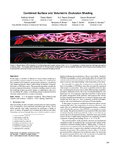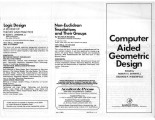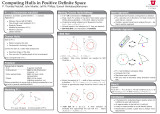|
|
Creator | Title | Description | Subject | Date |
| 176 |
 |
Balasubramonian, Rajeev | CHOP: adaptive filter-based DRAM caching for CMP server platforms | As manycore architectures enable a large number of cores on the die, a key challenge that emerges is the availability of memory bandwidth with conventional DRAM solutions. To address this challenge, integration of large DRAM caches that provide as much as 5× higher bandwidth and as low as 1/3rd of... | CHOP; DRAM caching; CMP server platforms; Manycore architectures; Hot page; Filter cache; Multi-core processors | 2010 |
| 177 |
 |
Kniss, Joe; Ikits, Milan; Lefohn, Aaron; Hansen, Charles D. | Closed-form approximations to the volume rendering integral with Gaussian transfer functions | In direct volume rendering, transfer functions map data points to optical properties such as color and opacity. We have found transfer functions based on the Gaussian primitive to be particularly useful for multivariate volumes, because they are simple and rely on a limited number of free paramet... | Volume rendering | 2003-07-25 |
| 178 |
 |
Hansen, Charles D. | Cluster-based interactive volume rendering with Simian | Commodity-based computer clusters offer a cost-effective alternative to traditional largescale, tightly coupled computers as a means to provide high-performance computational and visualization services. The Center for the Simulation of Accidental Fires and Explosions (C-SAFE) at the University of... | Volume rendering; Simian | 2003-09-03 |
| 179 |
 |
Lindstrom, Gary E. | Combinator evaluation of functional programs with logical variables | A technique is presented that brings logical variables into the scope of the well known Turner method for evaluating normal order functioned programs by S, K, I combinator graph reduction. This extension is illustrated by SASL+LV, an extension of Turner's language SASL in which general expressions s... | Functional programs; Logical variables; SASL+LV; Turner's language | 1987 |
| 180 |
 |
Hansen, Charles D. | Combined surface and volumetric occlusion shading | In this paper, a method for interactive direct volume rendering is proposed that computes ambient occlusion effects for visualizations that combine both volumetric and geometric primitives, specifically tube shaped geometric objects representing streamlines, magnetic field lines or DTI fiber tracts.... | | 2012-01-01 |
| 181 |
 |
Pascucci, Valerio | Combining in-situ and in-transit processing to enable extreme-scale scientific analysis | With the onset of extreme-scale computing, I/O constraints make it increasingly difficult for scientists to save a sufficient amount of raw simulation data to persistent storage. One potential solution is to change the data analysis pipeline from a post-process centric to a concurrent approach based... | | 2012-01-01 |
| 182 |
 |
Freire, Juliana | Combining scheduling strategies in tabled evaluations | Tabled evaluations ensure termination for Datalog programs by distinguishing calls to tabled subgoals. Given several variant subgoals in an evaluation, only the first (the generator) will use program clause resolution, the rest (consumers) must perform answer resolution using answers computed by th... | SLG; SLG-WAM; Tabling; Local scheduling; Batched scheduling | 1997 |
| 183 |
 |
Henderson, Thomas C. | Combining symbolic and numeric computation on the CRAY | It is now widely accepted that the CRAY supercomputers are very useful for large numeric applications, e.g., Finite Element Analysis, Fluid Dynamics, Image Processing, etc. Much work has been done to make them run efficiently on the CRAY. There has also been some effort to do symbolic computing (Al ... | CRAY supercomputers; Symbolic computation; Numeric computation | 1986 |
| 184 |
 |
Balasubramonian, Rajeev | Commit algorithms for scalable hardware transactional memory | In a hardware transactional memory system with lazy versioning and lazy conflict detection, the process of transaction commit can emerge as a bottleneck. For a large-scale distributed memory system, we propose novel algorithms to implement commit that are deadlock- and livelock-free and do not empl... | Commit algorithms; Scalable; Hardware; Transactional memory | 2007 |
| 185 |
 |
Gopalakrishnan, Ganesh; Kirby, Robert Michael II | The communication semantics of the message passing interface | The Message Passing Interface (MPI) standard is a natural language document that describes a software library for interprocess communication. Automatic reasoning about the reactive nature of programs communicating via MPI libraries is not possible without also analizing the library being used. Ma... | communication semantics; Message Passing Interface; MPI; natural language | 2006-10-31 |
| 186 |
 |
Zhao, Lu; Regehr, John | Comparing program logics for reasoning about safety properties | To prove memory write and controls transfers do not interfere with other programs in embedded systems. Hoare Logic with Bale Predicate; Hoare Logic with Separation Conjunction. | | 2010-10-06 |
| 187 |
 |
Kessler, Robert R. | Compiling distributed C++ | Distributed C++ (DC++) is a language for writing parallel applications on loosely coupled distributed systems in C++. Its key idea is to extend the C++ class into 3 categories: gateway classes which act as communication and synchronization entry points between abstract processors, classes whose... | Distributed C++; DC++; Parallel applications | 1994 |
| 188 |
 |
Sikorski, Kris | Complexity of computing topological degree of Lipschitz functions in n dimensions | We find lower and upper bounds on the complexity, comp(deg), of computing t h e topological degree of functions defined on the n-dimensional unit cube Cn, f : ?Cn Rn,n ? 2, which satisfy a Lipschitz condition with constant K and whose infinity norm at each point on t h e boundary of Cn is at least d... | Lipschitz functions | 1986 |
| 189 |
 |
Susarla, Sai R.; Carter, John | Composable consistency for large-scale peer replication | The lack of a flexible consistency management solution hinders P2P implementation of applications involving updates, such as directory services, online auctions and collaboration. Managing shared data in a P2P setting requires a consistency solution that can operate in a heterogenous network, sup... | P2P | 2003-11-14 |
| 190 |
 |
Lindstrom, Gary E. | Compositionally modular Scheme | We present a new module system for Scheme that supports a high degree of implementation reuse via module composition. The module system encourages breaking down a program into the smallest possible individually meaningful modules, and recomposing them using a powerful set of adaptation and combinat... | Module system | 1995 |
| 191 |
 |
Johnson, Christopher R.; Parker, Steven G.; Whitaker, Ross T.; Hansen, Charles D. | Computational field visualization | Today, scientists, engineers, and medical researchers routinely use computers to simulate complex physical phenomena. Such simulations present new challenges for computational scientists, including the need to effectively analyze and visualize complex three-dimensional data. As simulations become mo... | Volume rendering; Isosurface extraction; Ray tracing; Multi-field visualizations | 2001 |
| 192 |
 |
Henderson, Thomas C.; Sikorski, Christopher | Computational sensor networks | We propose Computational Sensor Networks as a methodology to exploit models of physical phenomena in order to better understand the structure of the sensor network. To do so, it is necessary to relate changes in the sensed variables (e.g., temperature) to the aspect of interest in the sensor netw... | Computational sensor networks | 2007 |
| 193 |
 |
Parker, Steven G.; Hansen, Charles D.; Johnson, Christopher R. | Computational steering and the SCIRun integrated problem solving environment | SCIRun is a problem solving environment that allows the interactive construction, debugging, and steering of large-scale scientific computations. We review related systems and introduce a taxonomy that explores different computational steering solutions. Considering these approaches, we discuss why ... | Computational steering; Problem solving environment; SCIRun; Volume rendering | 1997 |
| 194 |
 |
Riesenfeld, Richard F. | Computer aided design | The report is based on the proposal submitted to the National Science Foundation in September 1981, as part of the Coordinated Experimental Computer Science Research Program. The sections covering the budget and biographical data on the senior research personnel have not been included. Also, the sec... | | 1984 |
| 195 |
 |
Riesenfeld, Richard F. | Computer aided geometric design | This book contains the edited proceedings of the first International Conference on Computer Aided Geometric Design, an important new field that draws on the principles of computer science, mathematics, and geometric design. The list of contributors includes most of the leading researchers in the... | Computer aided geometric design | 1973 |
| 196 |
 |
Gouraud, Henri | Computer display of curved surfaces | This research describes a method for producing shaped pictures of curved surfaces. It uses a small polygon approximation of the surface to solve efficiently the nidden parts detection, and then computes the shading on each polygon in such a way that visual discontinuities between adjacent polygons d... | Curved surfaces; Computer display | 1971 |
| 197 |
 |
Fletcher, Preston Thomas; Moeller, John Henry; Phillips, Jeffrey; Venkatasubramanian, Suresh | Computing hulls in positive definite space | P(n): a Riemannian manifold Definition: symmetric positive-definite (n) (n) matrices Applications: Diffusion Tensor MRI (DT-MRI) Flow through voxel modeled in P(3) Elasticity Tensors Modeled by elements of P(6) Machine Learning Used in kernels Convex Hulls Data on P(n): Want to analyze... | | 2010-10-06 |
| 198 |
 |
Pascucci, Valerio | Computing morse-smale complexes with accurate geometry | Topological techniques have proven highly successful in analyzing and visualizing scientific data. As a result, significant efforts have been made to compute structures like the Morse-Smale complex as robustly and efficiently as possible. However, the resulting algorithms, while topologically consis... | | 2012-01-01 |
| 199 |
 |
Cohen, Elaine | Computing offsets and tool paths with Voronoi diagrams | In this paper we describe the use of Voronoi diagrams to generate offsets for planar regions bounded by circular arcs and line segments, and then use the generated offsets as tool paths for NC machining. Two methods are presented, each producing a different type of offset. One of them generates the ... | Voronoi diagrams | 1989 |
| 200 |
 |
Sobh, Tarek M.; Henderson, Thomas C. | Concurrent engineering and robot prototyping | This report addresses the theoretical basis for building a prototyping environment for electromechanical systems using concurrent engineering approach. In Designing a robot manipulator, as an example of electro-mechanical systems, the interaction between several modules (S/W, VLSI, CAD, CAM, Robotic... | Robot prototyping | 1993 |

























